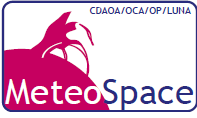Context
Solar activity is responsible for disturbances in our space environment, called space weather. In particular, solar activity produces specific structures, “filaments”, which are plasma prominences. These prominences sometimes erupt and eject particles at high energy in the heliosphere that can eventually reach the magnetosphere of the Earth. Their interaction with the magnetosphere disrupts the ionosphere and causes damage to our satellite and GPS communication systems. Space weather thus poses some risks to the Earth. To be prepared for and mitigate those solar risks, France joined the European Space Situational Awareness (SSA) program of ESA in 2016, and created the OFRAME group (French Organisation for Applied Research in Space Meteorology) in June 2017 to coordinate actions related to space weather. MeteoSpace is a project that contributes to these new French actions. It aims to develop and operate an automated instrument to observe the lower solar atmosphere (chromosphere) where the solar erupting filaments originate.
The METEOSPACE project
The instrument is made of three telescopes that will be installed at the Calern station of Observatoire de la Côte d’Azur. It is conceived to operate at high cadence and in wavelengths corresponding to those of ionized calcium and hydrogen H-alpha spectral lines which are formed specifically at temperatures and densities reached in the chromosphere. As Calcium and Hydrogen create different degrees of opacity, the solar structures revealed by these two electronic emissions are seen at different heights in the chromosphere and hence can be discriminated. Two H-alpha filters centered at slightly different wavelengths will be used to provide two synchronous images of the filaments at different heights. This will improve the accuracy of their detection. Movies of the difference between two successive images will depict the chromosphere dynamics and might thus reveal the large-scale shock waves (Moreton waves) that are sometimes induced by solar eruptions. This would be the first time that an H-alpha instrument provided movies, continuously and in real time, where those waves were observed.
Instrument description
 |
| Top: the MeteoSpace overall structure (0.5 × 0.5 × 1.7 m) enclosing three instruments; H = Hα; Ca = CaII K. Middle: details of the two Hα telescopes; E = energy rejection filter (Baader); L1 = entrance objective (Takahashi TSA102); L2/L3 = afocal magnifying system; F = DayStar Quantum PE Fabry Pérot filter; L4 = field corrector/focuser; M = focuser motor; C = cooled CCD camera (QSI 660i). Bottom: optical design of the Hα telescopes. |
 |
| The chamber of MeteoSpace Hα telescopes. L3 = chamber objective; F = DayStar Quantum PE Fabry Pérot filter; L4 = field corrector/focuser; M = focuser motor; C = cooled CCD camera (QSI 660i). |
 |
| The transmission curves of the line centered filter (black) and of the blue-shifted filter (blue) as a function of wavelength. The dashed line is the observed Hα line profile. |
Products
Simulation of typical images and movies which will be provided by the new instrument, based on 28 October 2003 data, from 10:41 UT to 11:22 UT (Meudon heliograph). Top: real-time processing will provide running difference of contrasts (left) and intensities (right) in the blue wing (Hα - 0.5 Å). Contrasts C are derived from intensities I after limb darkening (LD) correction (C=I/LD−1). Bottom: post-processing based on Muhr et al. (2010) method: base-difference between contrasts (left) or intensities (right) at time t and an offset measured before the event (reference time t0), combining blue wing and line core images of the two Hα telescopes.
Reference:
- Malherbe, J.-M., Corbard, T., Barbary, G., Morand, F., Collin, C.,Crussaire, D., Guitton, F., Monitoring fast solar chromospheric activity: the MeteoSpace project, Experimental Astronomy (2022) (doi:10.1007/s10686-022-09848-7) ⟨hal-03868980⟩
- Malherbe, J.-M., Corbard, T., Dalmasse. K., Optical instrumentation for chromospheric monitoring during solar cycle 25 at Paris and Côte d'Azur observatories. Journal of Space Weather and Space Climate 10 (2020) 31, EDP sciences, Topical Issue - Space Weather Instrumentation ⟨doi:10.1051/swsc/2020032⟩ (pdf)
- Malherbe, J.-M., Corbard, T., Dalmasse, K. and MeteoSpace Team "Meteospace, a New Instrument for Solar Survey at the Calern Observatory", Solar Physics, vol. 294, p. 177 (2019) (doi:10.1007/s11207-019-1569-5) ⟨hal-02462553) (pdf)
See also:
- Data Access
- Project description at UCA Academy 3: Space, Environment, Risk and Resilience
- Bibliography METEOSPACE and online documents
- Projet FEDOME FEdération des DOnnées de Météorologie de l’Espace
- Space Weather on CNRS newsletter:"Météo solaire, tempêtes et black-out"





